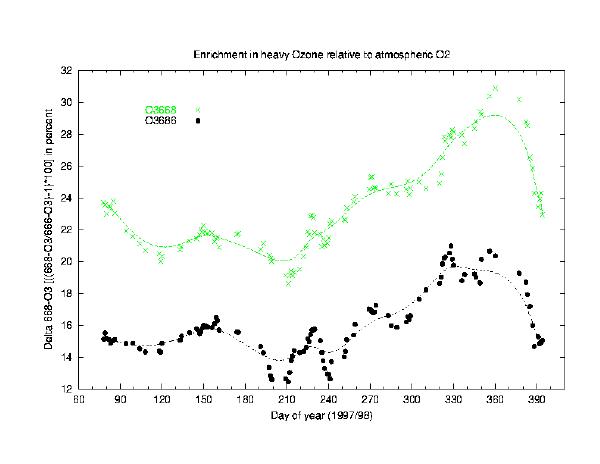
Previous: Data analysis Next: Water vapour Up: Ext. Abst.
Stratospheric ozone
Large isotopic anomalies have been reported for ozone in the past, with a pro nounced maximum in the stratosphere, but the obser vations are spatially and temporally limited (Mauersberger, 1981; Meier and Notholt, 1996; Irion et al 1996b). Although the experimental evi dence is very consistent, we are still short of a satisfac tory theoretical understanding (Krankowski & Mauersberger, 1996). Our inability to ex plain the observed isotopic composi tion im plies that we do not fully understand the ozone forma tion process. Current chemi cal models are known to show significant biases compared to observations when integrating the net ozone deple tion over a full winter period at high latitudes (Goutail, 1998), which coincides with par ticularly strong anomalies in the isotopic composition of ozone (Meier et al., 1998).
The very high enrichments observed (Fig.1) are consistent both with balloon borne in-situ measurements based on mass-spectrometric analysis (Mauersberger, 1981) and with FTIR observations both from ground at high latitudes (Meier et al, 1996 & 1998) and from space (Irion et al, 1996b). Recent laboratory studies (Mauersberger, priv.comm, 1999) have identified individual formation pathways of ozone that carry an enrichment of up to 50 %(!) while others show no enrichments at all. Although we have confidence that the enrichment in ozone is caused in its formation rather than in its numerous destruction processes, our theortical understaning remains fairly incomplete. Given that each sunlit ozone molecule in the middle stratosphere is photolysed and recycled every 30 min on average, small uncertainties in the formation process may have significant effects on the equlibrium concentration of total ozone.

Figure 1: This figure illustrates the isotopic enrichment of heavy ozone relative to atmospheric molecular oxygen in delta-notation. Studied are the two most abundant heavy isotopomers of ozone; i.e. 16O16O18O and 16O18O16O (O3-668, O3-686). Please note that both heavy species are of same mass (50) that cannot be destinguished by classical mass-spectrometry. The seasonal cycle shwon is the first reported for isotopical ozone. A maximum is found in the early Australian summer with a 30 % higher enrichment than found during winter. Both isotopomers are highly correlated though offset against each other. The precison of individual measuremnts are 2% in terms of enrichment and the solid line represents a spline fit to the daily mean values shown.
Previous: Data analysis Next: Water vapour Up: Ext. Abst.